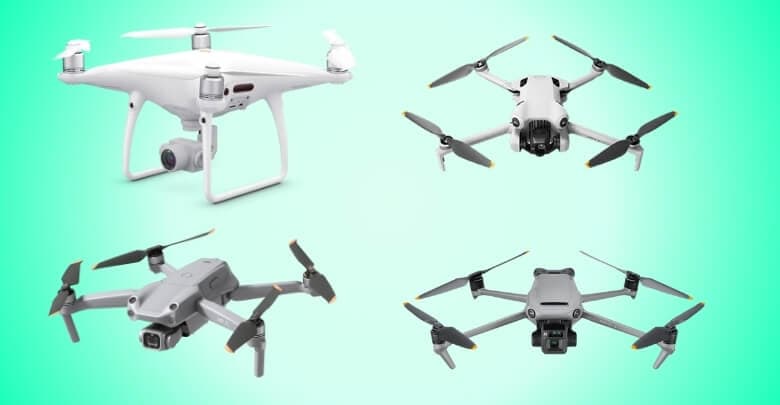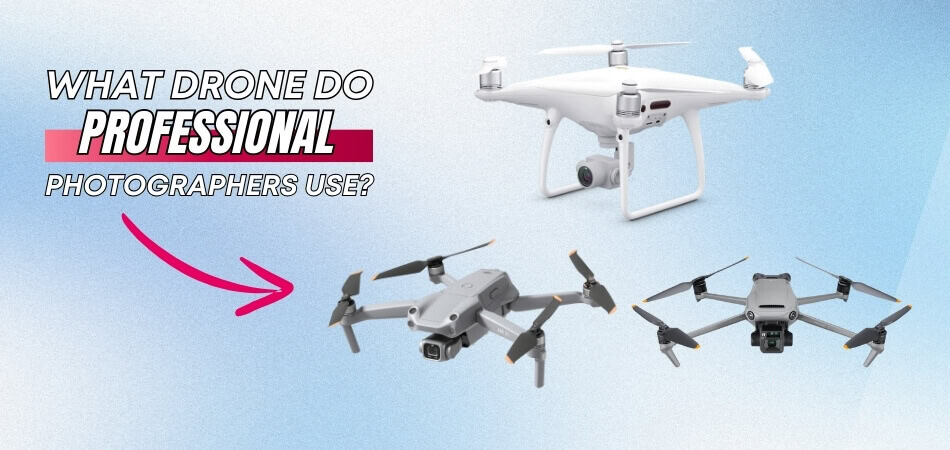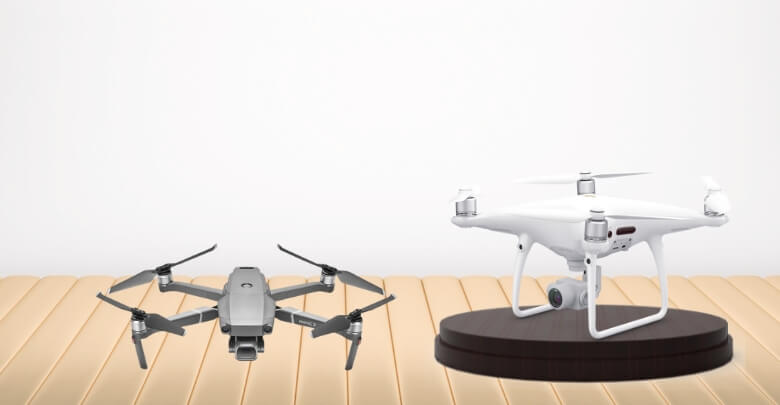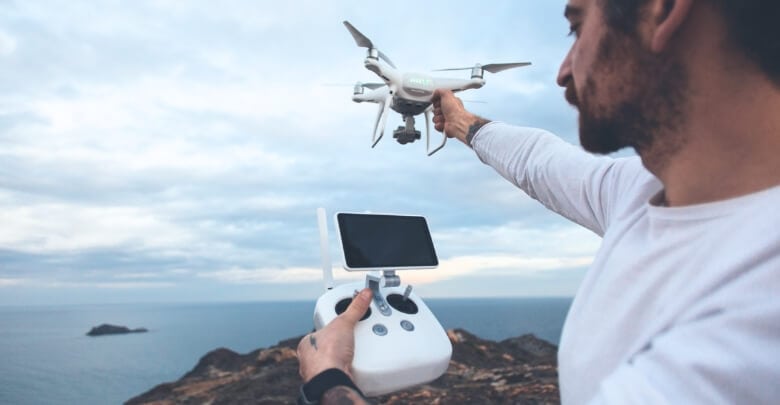Professional photographers always look for the best tools to enhance their skills in photography. So, when it comes to aerial photography, they’ll need drones that deliver top-notch performance. But, what drone do professional photographers use, is a question that always comes to mind.
Professional photographers generally use drones manufactured by DJI due to their reliability, advanced features, and high-quality imaging capabilities. DJI drones are renowned in the industry for their performance and versatility in capturing stunning aerial photography and videography.
Looking for more information about these drones and other options? Follow the rest of the article to dive deeper into the professional drones and discover which might suit you.
What Are Professional Photography Drones?
Professional photography drones have completely changed the way photographers capture images. These high-tech devices offer new perspectives and creative possibilities that were previously unobtainable. Making the most of their capabilities requires understanding what sets them apart.

Drones used by professional photographers are equipped with advanced cameras and features. They offer high-resolution imaging, stability in flight, and ease of use. These drones enable photographers to capture amazing aerial shots and unique angles effortlessly.
Nowadays, drones are popular choices among professionals. These tools are known for high-quality cameras and reliable performance. Reliable drones are essential tools for commercial drone photography that help provide excellent imaging and video capabilities.
Professional drones also come with intelligent flight modes. These include obstacle avoidance, GPS tracking, and automated flight paths. Such features ensure precision and safety, making them ideal for capturing high-quality images in various environments.
What Drone Do Professional Photographers Use?
Professional photographers use drones to capture unique aerial perspectives that add value to their work. The right drone can make a significant difference in image quality and creativity. Here’s a look at some DJI drone models that are used by professional photographers.

- DJI Phantom 4 Pro V2.0: The DJI Phantom 4 Pro V2.0 is a top choice for many professionals. It features a 20-megapixel camera with a 1-inch CMOS sensor. This drone offers excellent image quality and precise control. Its obstacle-sensing technology ensures safe and stable flights.
- DJI Mavic 3: The DJI Mavic 3 is renowned for its dual-camera system, including a Hasselblad camera. It provides exceptional color accuracy and dynamic range. Its compact design makes it easy to transport for on-the-go shoots. It is worth buying drone for photography, especially with these advanced features.
- DJI Air 2S: The DJI Air 2S is popular for its 1-inch CMOS sensor and 20-megapixel camera. It delivers stunning image quality and supports 5.4K video recording. The drone’s compact and foldable design enhances portability. Its intelligent flight modes simplify capturing complex shots.
- DJI Mini 3 Pro: The DJI Mini 3 Pro stands out for its lightweight and compact design. Despite its small size, it features a high-quality camera with a 1/1.3-inch sensor. It’s ideal for travel and quick deployments. The drone’s advanced features make it a powerful tool for aerial photography.
How to Choose the Right Drone for Your Photography Needs?
Choosing the right drone for photography can significantly increase your creative capabilities. Follow this step-by-step guide to find the perfect drone that meets your specific photography needs.

Step 1: Determine Your Photography Goals
Identify what you aim to achieve with drone photography. Different drones excel in various aspects like aerial landscapes, action shots, or architectural photography. Knowing your goals will help you choose the right features.
Step 2: Assess Camera Quality
Check the camera specifications, including resolution and sensor size. Higher resolution and larger sensors produce better image quality. Consider drones with features like adjustable apertures and advanced stabilization for optimal performance.
Step 3: Measure Flight Time and Range
Consider how long the drone can stay airborne and its maximum range. Longer flight times and greater ranges provide more flexibility for capturing diverse shots. This is crucial for extended outdoor sessions.
Step 4: Look for Stability and Control
Ensure the drone offers excellent stability and precise control. Features like GPS, obstacle sensing, and gimbal stabilization enhance flight performance. These elements are vital for capturing clear and sharp images.
Step 5: Consider Portability and Ease of Use
Portability is important if you plan to travel with your drone. Foldable designs and lightweight models are convenient. Additionally, user-friendly controls and intuitive interfaces make operating the drone simpler.
Step 6: Check for Advanced Features
Look for drones with advanced features like automated flight modes and intelligent shooting options. These can simplify complex shots and enhance creativity. Features like return-to-home and follow-me add to the overall experience.
Step 7: Assess Price and Value
Compare the drone’s price with the features it offers. Ensure you get good value for your investment. Sometimes, paying a bit more can significantly enhance your photography capabilities.
Step 8: Read Reviews and Recommendations
Research reviews from other photographers and industry experts. Their insights can provide valuable information about real-world performance. Recommendations can guide you toward reliable and high-quality drones.
Step 9: Consider After-Sales Support
Check the manufacturer’s after-sales support and warranty. Good customer service can be crucial if you encounter issues. A reliable warranty ensures your investment is protected.
Step 10: Make a Test Flight
If possible, test the drone before making a purchase. This allows you to check its handling and performance firsthand. A test flight can confirm if the drone meets your expectations.
Tips for Getting Started with Professional Drone Photography
Diving into professional drone photography can be both exciting and challenging. With the right approach, you can capture breathtaking aerial images. Here are some tips to help you get started on the right path.

Invest in A Quality Drone
Selecting a reliable drone with a high-quality camera is crucial. Look for features like 4K resolution and gimbal stabilization. These ensure sharp and professional-looking images. Don’t skimp on quality; it makes a big difference.
Learn the Basics of Drone Operation
It is essential to understand how to operate your drone safely and effectively. Practice flying in open areas to gain confidence. Familiarize yourself with the controls and features. This foundation will make your photography sessions smoother.
Master Camera Settings
Knowing how to adjust your drone camera settings can significantly improve your photos. Experiment with ISO, shutter speed, and aperture. Different conditions require different settings for optimal results. Practice these adjustments to capture the best shots.
Plan Your Shots
Checking out locations and planning your shots can save time. Use tools like Google Earth to find interesting angles. Consider the time of day for the best lighting. Proper planning results in more impressive photos.
Focus on Composition
Great composition is key to stunning drone photography. Use techniques like the rule of thirds to frame your shots. Look for interesting patterns and leading lines. The composition can turn ordinary scenes into extraordinary images.
Tips to Maintain the Drone
Maintaining your photography drone is crucial for its longevity and performance. Proper care ensures you get the best shots every time you fly. Here are some essential maintenance tips to keep your drone in top condition.
- Regularly Inspect Your Drone: Check your drone for any physical damage before and after each flight. Look for cracks, loose parts, and worn-out components. Inspect the propellers for any signs of wear. Regular inspections help prevent mid-flight failures.
- Clean the Camera and Sensors: Keeping the camera and sensors clean is vital for clear images. Use a microfiber cloth to wipe the camera lens gently. Avoid harsh chemicals that could damage the sensors. Clean sensors ensure optimal drone performance.
- Maintain the Battery: Proper battery care is essential for safe flights. Store batteries in a cool, dry place to extend their lifespan. Avoid overcharging and deep discharging to prevent damage. Regularly check battery health using the drone’s app.
- Update Firmware and Software: Keep your drone’s firmware and software up to date. Manufacturers release updates to improve performance and fix bugs. Regular updates enhance flight stability and feature access. Check for updates before each flight session.
- Safe Storage Practices: Store your drone in a protective case when not in use. This prevents dust and physical damage. Keep it in a dry, temperature-controlled environment. Proper storage prolongs the life of your drone components.
FAQs for What Drone Do Professional Photographers Use?
There are many options available when it comes to choosing the right drone for professional photography. Here are some frequently asked questions and their answers to help you make an informed decision.
How Does Flight Time Impact Professional Drone Photography?
Longer flight times allow for extended shooting sessions without frequent battery changes. This is especially useful for capturing multiple angles and locations in one session, enhancing productivity and creativity.
Why Is Gimbal Stabilization Important in Drones?
Gimbal stabilization is crucial for reducing camera shake and ensuring smooth, stable footage. It allows photographers to capture sharp images and fluid videos even in windy or unstable conditions.
Can Professional Drones Be Used for Videography as Well?
Yes, professional drones are often used for videography due to their high-resolution cameras and stable flight capabilities. Features like 4K video recording and advanced stabilization make them ideal for capturing high-quality videos.
How Important Is Portability in A Professional Drone?
Portability is important for photographers who travel frequently. Foldable and lightweight drones are easier to carry and deploy, making them convenient for capturing aerial shots in various locations.
What Safety Features Should a Professional Drone Have?
Safety features like obstacle avoidance, GPS tracking, and return-to-home functionality are essential. These features prevent crashes and ensure the drone returns safely, protecting your investment and ensuring consistent performance.
Are Software Updates Important for Professional Drones?
Yes, software updates are important as they improve drone performance, fix bugs, and introduce new features. Regular updates ensure your drone operates smoothly and takes advantage of the latest advancements.
Final Thought
Photographers can greatly benefit from drones, which allow them to capture beautiful aerial shots for their portfolios. Photography drones include the DJI Phantom 4 Pro, DJI Mavic 3, DJI Air 2S, and DJI Mini 3 Pro. Commercial drone photography requires excellent imaging capabilities.
Drones should be selected based on key factors such as camera quality, flight time, stability, and portability. Knowing “What drone do professional photographers use?” can help you select reliable models. Mastering camera settings and planning your shots can also help you improve your photography skills.

